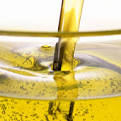CABREUVA

















CABREUVA ESSENTIAL OIL
Myrocarpus fastigiatus
Family: Fabaceae (Leguminosae)
Synonyms:Cabureicica, 'Baume de Peru brun'
General Description: A graceful, tall tropical tree, 12-15 metre high, with a very hard wood, extremely resistant to moisture and mould growth. It yields a balsam when the trunk is damaged , like many other South American trees.
Distribution: Found in Brazil, Paraguay, Chile and north Argentina.
Other Species: Many varieties of Myrocarpus yield carbreuva oil, such as M. frondosus. It is also botanically related to the trees which yield copaiba, Peru and Tolu balsam.
Herbal/Folk Tradition.The wood is highly appreciated for carving and furniture making.
It is used by the natives to heal wounds, ulcers and obviate scars. It was once listed in old European pharmocopoeias for its antiseptic qualities.
Actions: Antiseptic, balamic, cicatrisant.
Extraction: Essential oil by steam distillation from wood chippings (waste from the timber mills).
Characteristics: A pale yellow, viscous liquid with a sweet, woody-floral scent, very delicate but having great tenacity. It blends well with rose, casie, mimosa, cedarwood, rich woody and orential bases.
Principal Constituents: Mainly nerolidol (80 percent approx), farnesol, bisabolol, among others.
Safety Data: Non-toxic, non-irritant, non-sensitizing.
Aromatherapy/Home Use
Skin care: Cuts, scars, wounds
Respiratory System: Chills, coughs.
Immune System: Colds
Other Uses:Fragrance component and fixative in soaps and high class perfumes, espically floral, woody or oriental types. Previously used for the isolation of nerolidol, now produced synthetically.
Reference: The Encyclopedia Of Essential Oils:Julia Lawless
Articles Latest
- CARDAMON
- CARAWAY
- CANANGA
- CAMPHOR
- CALAMUS
- Calamintha-Calamintha officinalis
- CAJEPUT- Melaleuca cajeputi
- Plant Expression
- Molecular Target: Cell Membrane
- CADE Essential Oil
- CABREUVA
- The Kashmiri rose oil worth millions
- Agarwood: The natural treasure worth more than gold whose heady scent is driving it towards extinction
- Nonselective Binding to Proteins: The Science of Advanced Aromatherapy
- Molecular Target: DNA, RNA, and Gene Expression
- BUCHU - Agothosma betulina
- BROOM - SPANISH - spartium junceum
- BORONiA - Boronia megastigma
- BORNEOL - Dryobalanops aromantica
- Boldo Leaf - Peumus boldus
- Birch White-Betula Alba
Articles-Most Read
- Home
- Balsam Canadian - Abies balsamea
- Copaiba Essential Oil
- Balsam Peru
- Basil French - Ocimum basilicum
- North America: Tea Tree and Monarda-3
- Basil Exotic
- North America: Tea Tree and Monarda-2
- Exploring Transcultural Constants
- Thyme Essential Oil
- Balsam Tolu
- Palma Rosa
- The Bioactivity of Essential Oils
- Benzoin - Styrax benzoin
- Why Pharmacology Cannot Demonstrate Essential Oil Efficacy
- Bay - West Indian - Pimenta racemosa
- Exploring Essential Oil Activity The Conventional Way
- Aromatherapy: An Answer
- Complex information From Plants
- Contacts
